So, you have an idea to create your application. It’s great! You probably already imagine how many difficulties you will face in the process. Now you have to go through many steps, starting from the formulation of the idea and ending with the launch of advertising for the finished product. But do you know anything about the concept of a minimum viable product?
Quality projects usually involve creative specialists, consultants, software developers, designers, and marketers. The work of all these people is worth a lot of money if you aim for a quality project.
But not all startups are successful, and there is a risk of losing a large amount of money if users don’t like the application.
To avoid this, you can opt for a minimum viable product. In our article, you will learn what an MVP is, why your business needs it, which successful companies started with small startups, and how to create a roadmap for MVP.
Why do some new startups fail?
A startup can fail for several reasons: an unviable idea and poor implementation. Perhaps the audience isn’t interested in the finished product. Or the new application is inconvenient for users. Or maybe the right target audience just doesn’t know about the finished app because of bad marketing.
According to recent Investopedia studies, about 20% of startups fail in their first year. The main reasons are an incorrect assessment of monetary investments and an incorrect approach to the target audience.
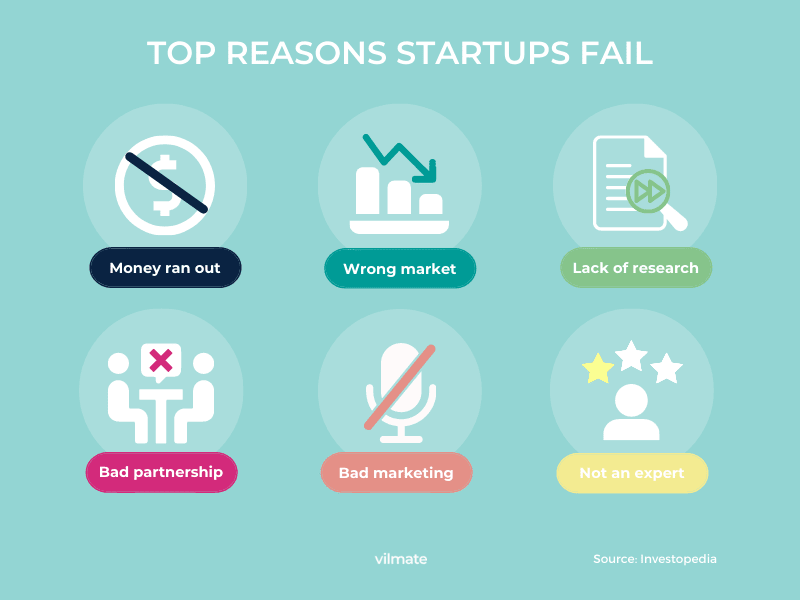
Of course, audience assessment is a must for any large-scale project. But will the finished product match people’s expectations? This is where MVP comes in handy.
What is MVP?
A minimum viable product (MVP) is a beta version of an application that contains basic functionality which demonstrates its essence. The goal of a minimum viable product is to ensure that the product enters the market early and to get the first audience and their feedback.
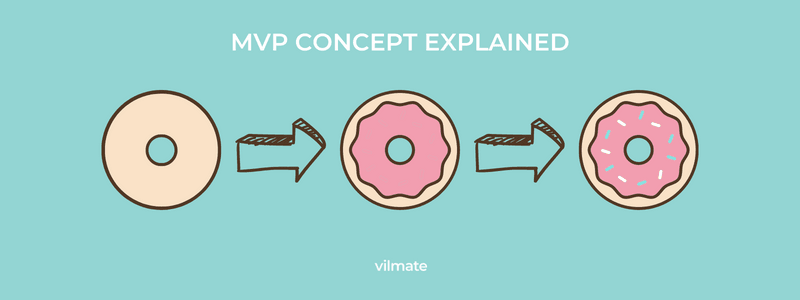
MVP allows you to understand the value of the future product, adjust its functions, and even understand what the UX/UI design should be like.
When using a minimum viable product, the user consciously agrees to help improve the final implementation. This feedback can be received at all stages of product development. The team can add new features at the request of users or not spend time and money on improving options that are not in demand.
MVP is the basic concept of agile software development methods. Agile methodology is based on an interactive tool of user influence on the product.
The decision to develop a startup is based on some owner assumptions about the following:
- importance of the product in the market
- profitability of the product
- possible investments
- successful implementation of the idea
All of these assumptions can not necessarily be true. Many years of experience and deep theoretical knowledge cannot give a 100% guarantee of success. In this case, the best solution would be to create an MVP.
Why does your new product need an MVP?
The concept of MVP exists to realize the value of the product. It requires:
- Minimum effort
- Minimum time
- Minimum investment
At the same time, the profit is huge. It gives confidence in the viability of the business and the almost complete absence of risks. At the same time, at the end of the study, you will have a product in your hands that’s ready to enter the market and already has customers.
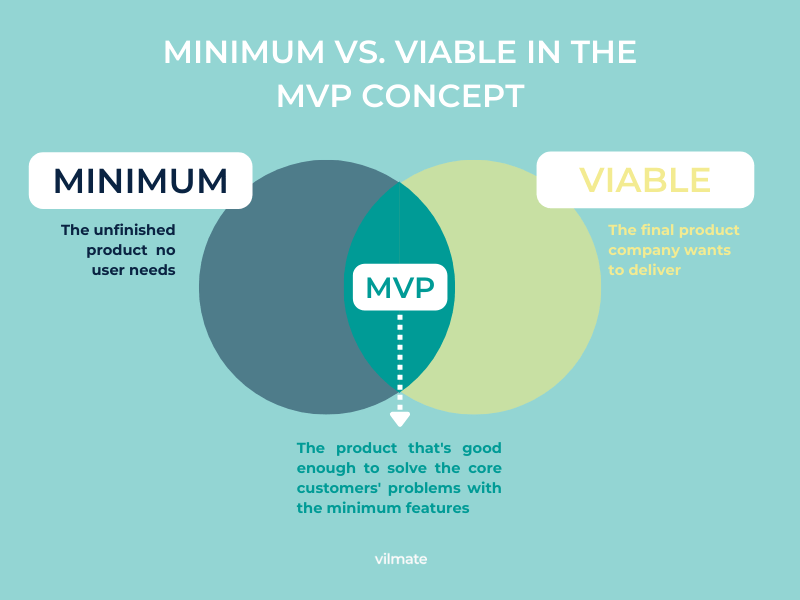
But if you perceive the minimum viable product, discarding the word “viable” and focusing on “minimal”, then there is a risk of making a mistake. If you provide customers with a low-quality minimum viable product, then you can get a bad user experience and negative reviews.
Mind that negative feedback doesn’t necessarily mean that the idea is bad. You just have to be able to bring it up.
The minimum viable product is a proposal for startups and fresh ideas. When can you skip the MVP step?
- If similar successful products already exist on the market.
- If you have a request from users to develop a product.
It should also be taken into account that during the development of the fully-fledged product, software developers will be heavily loaded, constantly changing the project. However, if you have the energy and time, then developing an MVP will be beneficial in such situations as well.
Now let’s consider in which case you definitely need a minimum viable product:
- You don’t want to waste time and want to get the product to market quickly.
- You are creating a fundamentally new product.
- Some of the features don’t have internal demand yet.
- You have no idea exactly what the finished application will look like.
- You want to save money.
The main advantage of a minimum viable product is that commercial recognition begins to appear very early. It turns out that MVP is a great marketing strategy that can make a brand famous instantly.
People like to feel important and heard. When they are directly involved in the product development process, the trusting relationship with the brand grows. MVP allows you to constantly warm up the interest of users. There is a higher chance that the project will not be forgotten and will be eagerly awaited for its full release to the market.
Benefits of launching an MVP
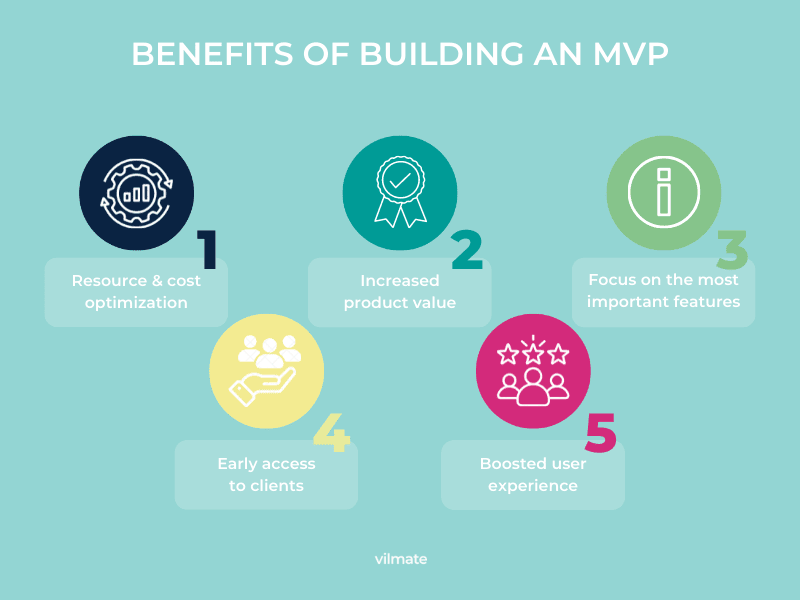
Using an MVP provides the following benefits:
- Resource & cost optimization
Your developers, designers, and marketers will spend less effort if the project isn’t successful. Businesses can save money. If the MVP is successful, the popularity of the product will increase.
- Increased product value
Monitoring user feedback will help make the application better and more convenient. This is the best way to learn about the advantages and disadvantages in practice.
- Focus on the most important features
MVP allows you to focus on the features you need and discard the ones you don’t. Thus, you optimize money and budget. Also, users can suggest feature ideas that your team didn’t think of.
- Early access to clients
MVP allows you to build relationships with customers right away. By their number, you can immediately understand what commercial benefits will go to the business budget. You will understand how the solvent audience responded to your product, and you will be able to correlate the price of the app and in-app purchases.
As a plus, with early access, you can estimate how much the costs of applications will be covered later.
- Boosted user experience
People rarely know what they really want. Therefore, standard surveys of the target audience will not give a complete understanding of the needs. Moreover, remote users will not be able to evaluate and adjust the convenience of the interface.
Thorough user experience research will help people understand what they want from the product and what is required from the developer.
MVP benefits: Summing up
For centuries, people have thought about how to get rid of risks by inventing a business. The minimum viable product significantly reduces the possibility of losing money, if not eliminates it. What’s more, if the MVP didn’t generate much interest at the initial stage, it’s much easier to change and adjust it to still attract people.
An MVP will allow your application to grow about 20 times faster. One of the important factors is the motivation of the development team. Work on a project that shows success in the initial stages and promises big profits goes better.
Many successful companies today started their journey with an MVP. Let’s talk about them.
Global companies that have successfully used MVP
Nothing says more about the importance of MVPs than successful examples of their application. Facebook is considered the most successful commercial project that started with a minimum viable product.
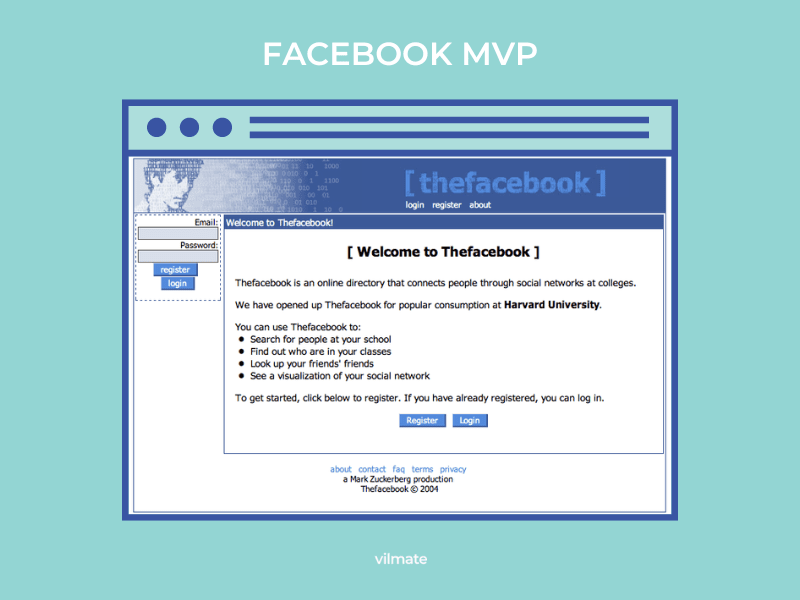
The Facebook MVP was called "TheFacebook" and was a simple platform for college students. There were not so many functions, and the main focus was on the ability to exchange messages. Students tried to communicate about the proposed product and left feedback. Because of the feedback, Facebook has changed to be suitable for a wider audience. Today, the site has 1.3 billion registered users.
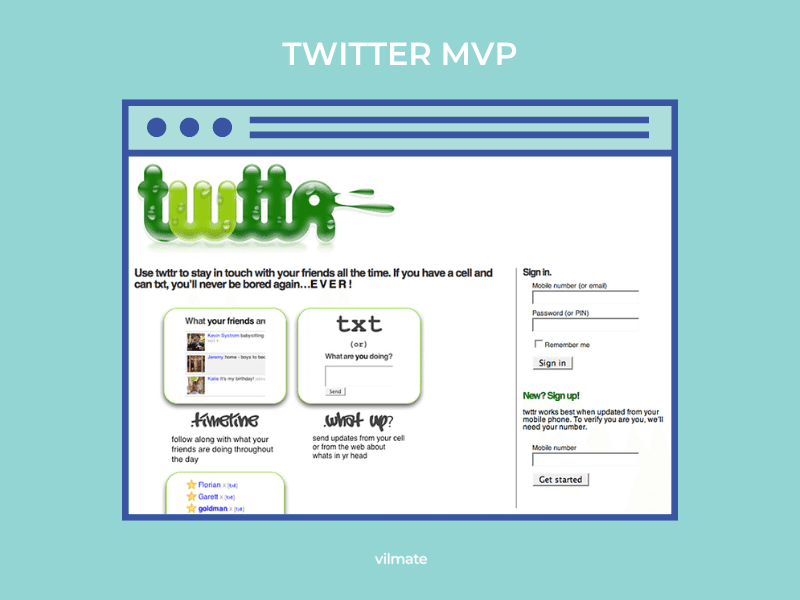
Twitter also started with an MVP. The company behind the project was having a hard time due to Apple’s pervasive iTunes monopoly. Therefore, the developers of Twitter couldn’t afford to invest heavily in their new product. And the product idea has already taken its shape - a platform based on SMS with a limited number of characters.
The MVP was called “twttr”. At first, it was used only by employees of the company, improving the user experience. Then some other users were launched into the minimum viable product for testing. And when Twitter entered the big market, it only took a year for it to gain huge popularity.
Amazon
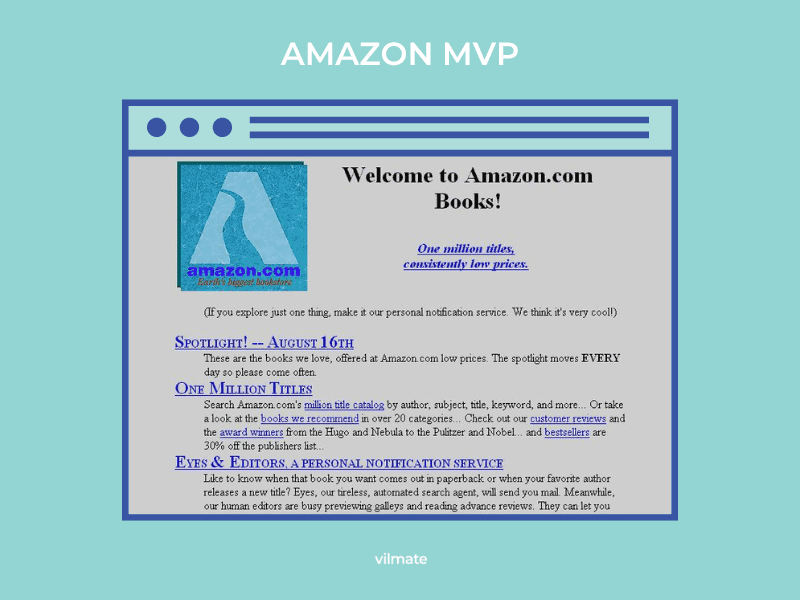
Amazon was originally a platform for selling books online. It had to compete with many bookstores around the world. The design was simple, and the focus was on functionality. When users liked the concept, the company began to make money and was able to improve the features and grow into a huge platform, the most popular in the world.
Dropbox
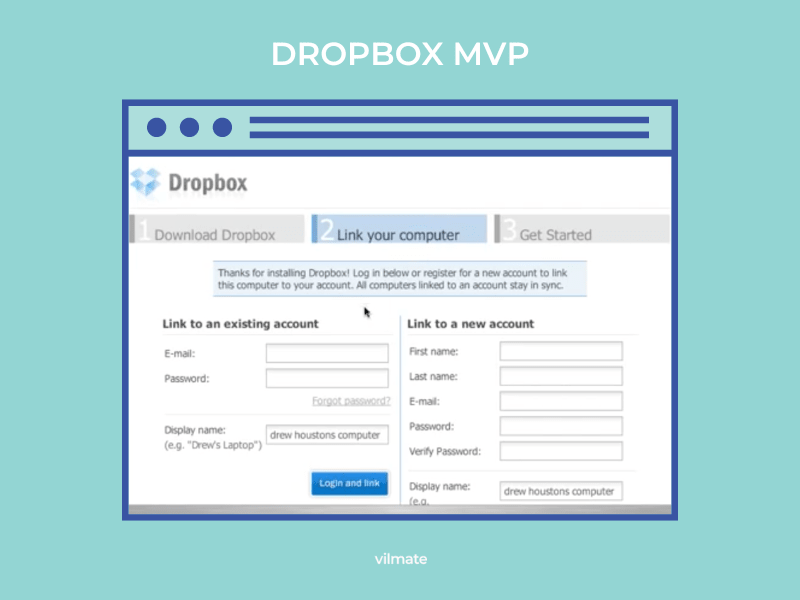
Dropbox has beaten a lot of competition with its MVP. There were many cloud storage offers, so there was no time to waste. Drew Houston, the author of Dropbox, has created a video in which he talked about his application. It gained interest and support from users at a very early stage.
Nike
Nike used the concept of MVP in an interesting way. They already had a successful application, but they needed to introduce a massive and expensive feature. The company created a beta version of the product, which received negative feedback. Therefore, Nike managed to save a serious amount of money.
Most likely, you also want to get similar popularity in the market. Then it’s time to create a minimum viable product! But how to do that?
How to create a roadmap for MVP?
A product roadmap is a visual concept that details goals, steps, and results. Having a roadmap is necessary for any product and for any MVP development stages. A strategy roadmap is a detailed plan on which the product development process will be based. It will help coordinate the actions of all employees who work on the project.
The roadmap may change depending on various factors. You can’t deviate from the plan, but you can make important changes. A good roadmap can attract investors even at the MVP stage.
Let’s take a look at the main steps showing how to create an MVP roadmap.
Six steps on building a roadmap for your MVP
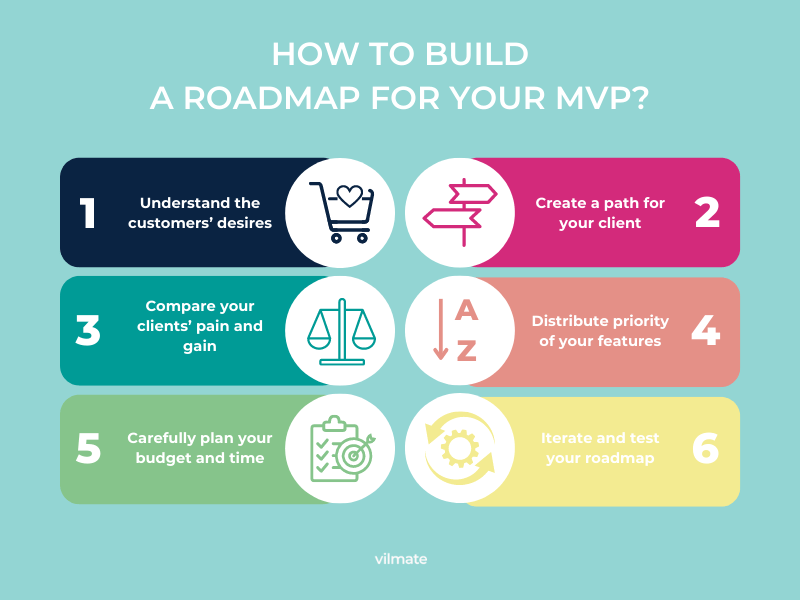
Step 1. Understand the customers’ desires
A deep analysis of the market and competitors is the basis for MVP development. To do this, you need to clearly understand for what purposes you need a minimum viable product and what kind of response you want to get.
First, it’s important to analyze what customer problems your application or site can solve. Try to understand how the product will benefit the client and what its value is. Compare the data received with the benefit that you could receive.
Imagine your ideal client: their age, gender, hobbies, and financial situation. This is what user experience design is based on.
It’s necessary to write a detailed description of the value of the product. The description should illustrate customer benefits and feature offerings that can cover them.
If you have had successful startups in the past, conduct user interviews. Find out what aspects caught their attention and what they consider an important advantage of your brand. If it’s your first endeavor, find at least a minimally similar competitor and search among its audience.
Creating a completely new project and finding an audience from scratch is called the Blue Ocean Strategy.
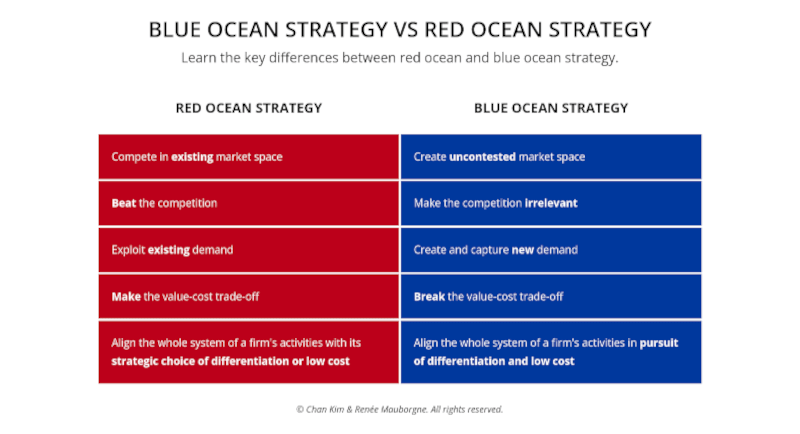
Blue Ocean is considered to be more effective than Red one, which is based on legacy user experience. It allows you to cross out competition from the product roadmap and dictate your own terms in the market.
To make a completely new product, you need to conduct user research and find its pain points. Uncovered in-demand options can give a good start to your product.
Step 2. Create a path for your client
How will the right client find your application? This is the next question to ask. If you have any idea what your ideal client is like for your MVP, you need to draw their path on the roadmap.
You can use the following algorithm.
- Set a starting point
Where will the client come from? Will a random user want to use the product? Will the user stay after the first acquaintance with the product?
- Set a finishing point
Where will the client go? What does the client need to do to make a profit? What problems will the user solve with the product? Why would he leave the app installed after reaching his goal?
- Draw a line
How to bring the client to the desired result? What features will stimulate processes?
Try to put yourself in the user’s shoes. Let more people tell about their impressions and desires. Planning the customer journey on the MVP roadmap will help you create the necessary statistics and understand the priority of processes.
In an MVP, it’s especially important to focus on the essentials. From this point derives the next step.
Step 3. Compare the client’s pain and gain
You understand what needs a potential customer has. It needs to be written in one part of the table. In another part of the table, write ways to solve the customer’s problems.
These methods will become the main functionality of your product. When compiling an MVP roadmap, you should focus only on the most important thing and leave everything else for later.
Step 4. Distribute features’ priority
You’ve mapped out the client’s pain and gain. Now you have to prioritize the implemented functionality. The key to MVP is launch speed and early feedback. Business is interested in them being positive.
There is a MoSCoW approach to determine the importance of features. This abbreviation combines 4 important components: Must-have, Should-have, Could-have, and Won’t-have.
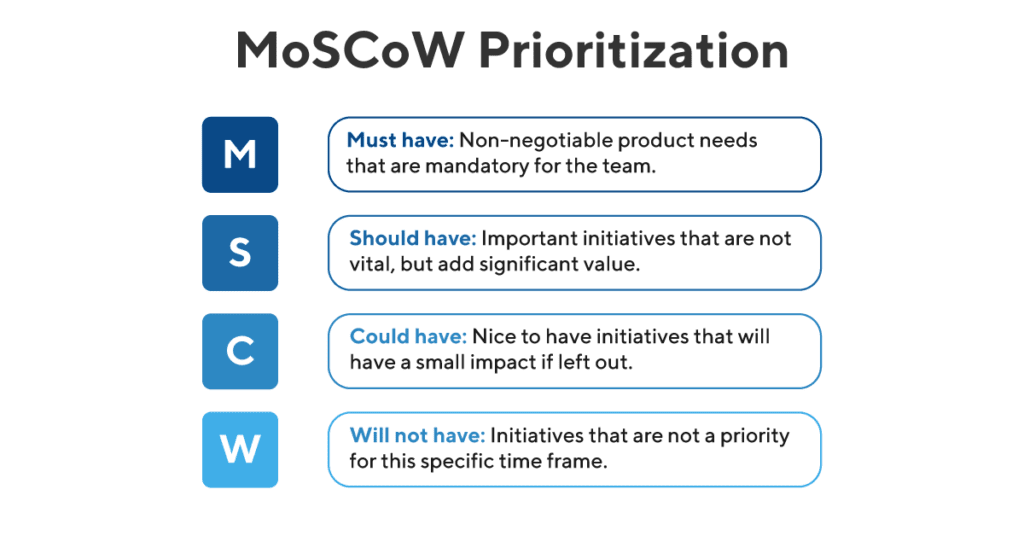
In building an MVP roadmap, you need to pay maximum attention to the first component: Must-have. All functions from this sector must be worked out perfectly. This is the basis of your product.
The Should-Have component should not be ignored either. But it’s better to postpone a thorough study of functions to the stage when the Must-have functions get the first positive effect.
Could-have options can be left to future product improvements. And the Won’t have functions shouldn’t be categorically abandoned. Or the user feedback will provide other information, and this functionality will move to another category.
Step 5. Carefully plan your budget and time
When the project plan is ready on the MVP roadmap, you need to deal with organizational issues. The most important aspect will be budget allocation and scheduling.
The budget will depend on the correct schedule, as it includes the payment of employees. Therefore, deadlines for certain tasks are often set not from real ideas but from budget considerations.
Step 6. Iterate and test your MVP roadmap
Your plan is ready, and now you need to start working and monitoring your progress. At the moment, all that is required is a correct implementation and careful analysis of the results.
And now, let’s take a closer look at the latest point to determine how to use MVP and what mistakes many businesses make.
How to realize the potential of your released MVP?
A large percentage of MVP product developments fail because of developer attitudes, not because of a bad idea. There is a misconception that an MVP is just a product that works for several months before launch. This is not true. A minimum viable product is a living organism that requires a sensitive attitude.
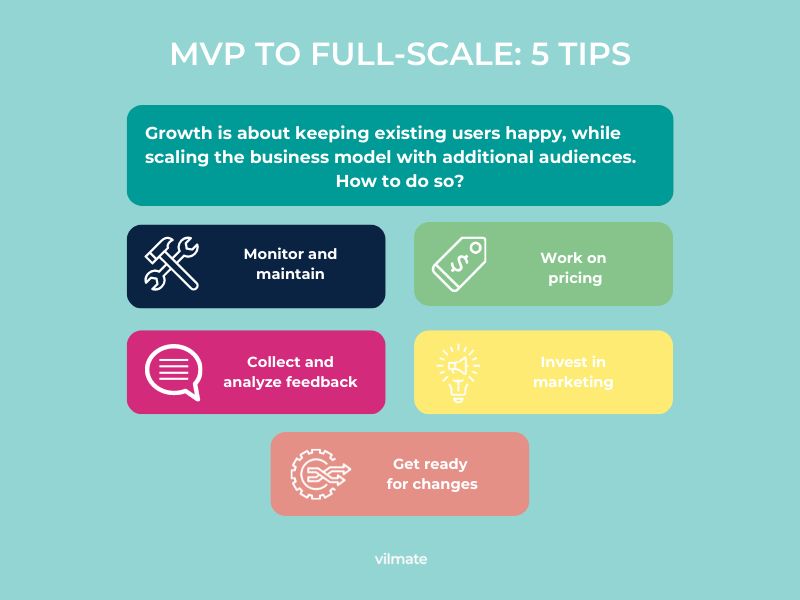
- Monitor and maintain
The QA team must test the MVP so that the user doesn’t encounter technical difficulties. Software bugs can ruin the customer experience, and the reviews won’t be representative.
- Collect and analyze reviews
Feedback is the main benefit of an MVP and should be used to its fullest. Based on user feedback, you should change the functions and adjust the operation of the product. Also, you can opt for A/B testing, or split testing, to evaluate your assumptions.
- Get ready for change
MVP is built to save money. But budget injections are still needed so that the startup doesn’t fail.
The cost savings can wipe out a good startup. For example, TaskBob, a household services startup, failed to scale to meet customer demands in time, even though it made $5.7 million initially.
Trust that the investment will pay off. If customers ask for additional features, then they are already interested in the offer.
- Work on pricing
Some startups want to earn more at the MVP stage. Some startups believe that you can’t charge money for a product that isn’t ready yet. Both of these approaches are wrong.
Correct prices will help users immediately understand what awaits them in a ready product. Free content that becomes paid at release is more likely to alienate a large percentage of customers.
But, of course, you must understand how much the client is willing to pay to solve a particular problem. Too high prices will alienate a large audience.
Respond to user requests. Raise prices for the most requested options. Reduce the cost if the percentage of paying customers is too low.
- Invest in marketing
MVP marketing doesn’t have to be big – it has to be right. To completely abandon marketing means losing a large mass of reviews and customers. Start advertising right away, but plan your goals correctly. The main thing is to make marketing honest.
Now we need to analyze the feedback and profit from the MVP development to understand if the idea is ready for implementation.
MVP launch: What’s next?
Read reviews to understand if the target audience is chosen correctly, how to improve the product, and what is the real value of the idea. The words of customers are a quality indicator.
The most important indicator is, of course, quantitative.
- How many users have tried your product?
This indicator will help to understand whether the marketing strategy is chosen correctly and whether the audience likes your product. If the user flow is stable, you are doing everything right.
- How many customers left positive feedback?
The percentage of positive and negative reviews will help you understand if the features and design are right.
- What are the churn and bounce rates?
The outflow of the audience is an inevitable process. You just have to pay attention to its quantity, and preferably also the reasons.
Conclusion
So, in this article, we’ve discussed the concept of MVP. Also, we’ve talked about the advantages of the MVP approach and appreciated the experience of well-known companies. Also, now you know how to create a roadmap for MVP.
MVP will significantly save money, effort, and time if you create it correctly and listen to users. Your new product should be successful with the right approach. Vilmate can help with the MVP development for startups and their implementation. We have all the right people who have in-depth knowledge of launching successful products.




